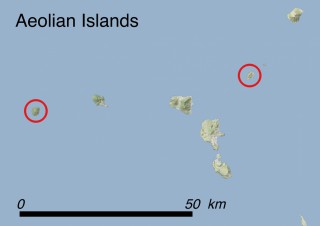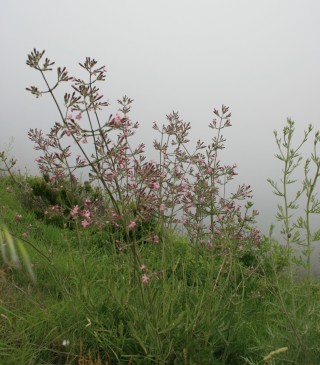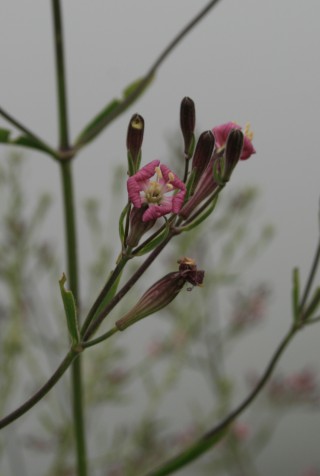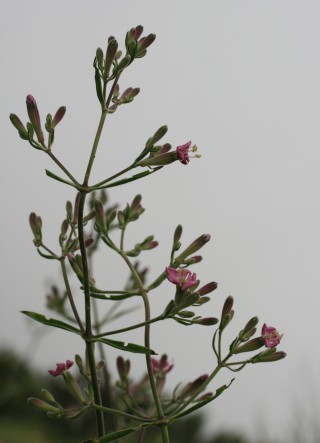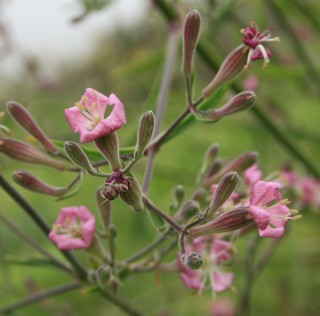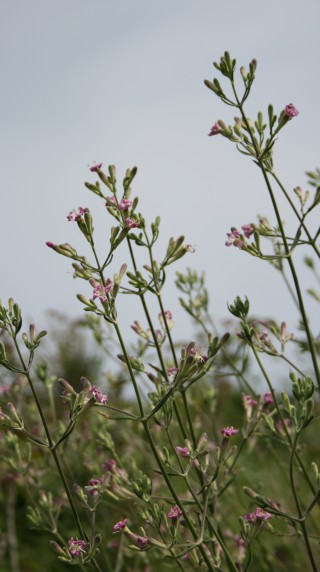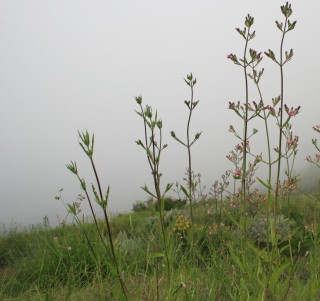Where is it found ?
Silene hicesiae is endemic to the Aeolian Islands. The population of Panarea covers an area of ca. 0.13 Km2 with 1000-2500 individuals. here It does not show a clear fidelity to cliff habitats and it mostly occurs on steep and stony slopes as part of a grassland community dominated by Brachypodium retusum (habitat 4.4.1: Temperate grassland - Dry grassland), while the small and even more scattered population of Alicudi (some 50 individuals covering less than 400 m2) is only found on volcanic cliffs and ash debris (habitat 6.5: recent volcanic features). The two known populations are situated ca. 60 km apart.
How to recognise it ?
Silene hicesiae is a low-growing shrub that may be up to 30-50 cm tall. It produces both sterile and fertile rosettes with densely hairy, elliptical leaves, 1-2 cm broad, 3-10 cm long. The fertile rosettes produce a hairy, usually non-branched flowering shoot with a 30 to 70 cm long stem with bunches bearing pink or pale pink 5-petal flowers which open in May. The fruits ripen between July and August. The main dispersal mechanism is barochory.
Interesting facts
Silene hicesiae belongs to the “Silene mollissima group”, which includes at least seven species endemic to the coastal cliffs of the western Mediterranean basin. These different species may have evolved when the Mediterranean was almost completely dry during the late Miocene, i.e. ca. 5 millions years ago, and the isolation of the remnant populations of a common ancestor gave rise to several new species. Therefore, this species could be one of numerous examples demonstrating how geographic isolation of populations belonging to the same species may lead to the evolution of new species through genetic divergence mechanisms. However, also alternative hypotheses on the origin of the species of this group have been recently proposed, suggesting a more recent differentiation of the Silene mollissima group.
Why is it threatened ?
This species is categorized as VU (Vulnerable) according to IUCN Red List Criterion D2. The two subpopulations cover an area of 3-4 ha, while the EOO of the species is less than 100 km². The whole population is severely fragmented, with more than 95% of individuals concentrated at Panarea, but the number of subpopulations and mature individuals appears to be stable. However, considering that half of the perimeter of the islet of Alicudi is formed by steep cliffs which are very hard to be explored, it is highly probable that the size of the local population is currently underestimated due to incomplete field surveys.
Silene hicesiae is mostly threatened with wildfires (threat 7.1.1: Fire and fire suppression - Increase in fire frequency/intensity) and browsing by introduced herbivores at Alicudi (mostly sheep, but also rabbits). As for the main subpopulation of Panarea, it is threatened by the overwhelming competition of Agrostis sp., whose native status is doubtful, and has become increasingly frequent in the site during the last 20 years (threat 8.2.1: Problematic native species/disease - unspecified species) and Ailanthus altissima, an invasive alien plant (threat 8.1.2: Invasive non-native/alien species - Named species), by the mechanical damages and trampling of the individuals which grow along the trekking paths of Panarea by hikers (threat 6.1. Recreational activities), by the gathering of flowering stems (threat 5.2.1: Gathering terrestrial plants - Intentional use), and by unintentional cutting during path maintenance/cleaning (threat 6.3: Work and other activities).
What has been done to protect it ?
Legally: This species is listed as a priority species in Annexes II and IV of the EC ‘Habitats’ Directive. The islets of Alicudi and Panarea are nature reserves where the collection of Silene hicesiae is strictly forbidden and its protection figures among the actions of the Management Plan of Aeolian Natura 2000 Sites. However, these rules may be totally neglected due to the lack of rangers watching the behaviour of hikers and tourists within the protected areas.
In situ: A number of conservation measures have been implemented as part of the EU LIFE project “Conservation of priority species of the Eolian Islands’ flora - EOLIFE99” (http://web.tiscali.it/ecogestioni/eolife) such as the improvement of the knowledge on the biology and ecology of Silene hicesiae, the reinforcement of wild populations with plants propagated ex situ, the cultivation in botanical gardens and seed-banks, as well as informing decision-makers, stakeholders and improving public awareness.
Ex situ: in the framework of the projects GENMEDOC (http://www.genmedoc.org) and SEMCLIMED (http://www.semclimed.org) seeds have been collected ca. ten years ago and stored in the seed banks of the University of Catania.
What conservation actions are needed ?
At Panarea Ailanthus altissima should be eradicated, starting from the stands which are spreading near Silene hicesiae. Further field investigations on the ecology, demography and distribution of the species are needed to improve in situ conservation policies. However, instead of been continued and implemented, the conservation programme initiated by EOLIFE99 is currently stalled due to a dramatic shortage of funding for environmental research at national and regional level.
Scientific coordination
Dr. Salvatore Pasta, Department of Biology, University of Fribourg, Switzerland.
Dr. Angelo Troìa, Dipartimento STeBICEF, sezione di Botanica ed Ecologia Vegetale, Università degli Studi di Palermo, Palermo, Italy.
Photos
Pietro Lo Cascio, Associazione ‘Nesos’, Lipari (http://www.nesos.org/), Italy.
